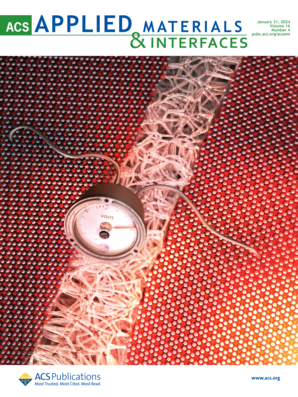Construction of [89Zr]Zr-Labeled Human Umbilical Cord Mesenchymal Stem Cell-Derived Extracellular Vesicles for Noninvasive Detection of Tumors.
IF 8.3
2区 材料科学
Q1 MATERIALS SCIENCE, MULTIDISCIPLINARY
引用次数: 0
Abstract
Extracellular vesicles (EVs) act as carriers that transfer molecules between donor and recipient cells, thereby altering the phenotype and function of the latter. EVs derived from mesenchymal stem cells (MSCs) inherit the homing ability of their parent cells to tumor sites. We speculate that MSC-derived EVs labeled with the isotope zirconium-89 ([89Zr]Zr) will accumulate within tumors and have the potential for tumor location via positron emission tomography (PET) imaging. Here, as a proof of concept, we used [89Zr]Zr-labeled human umbilical cord MSC (hucMSC)-derived EVs to characterize the homing of EVs to tumor regions via PET imaging. The uptake of [89Zr]Zr-DFO-hucMSC-EVs by 4T1, H292, and FaDu cells increased in a time-dependent manner. [89Zr]Zr-DFO-hucMSC-EVs were rapidly cleared from the blood circulation, showing a 2-phase exponential decay with a biodistribution half-life of 0.46 h and an elimination-phase half-life of 11.87 h. At 24 h postinjection, [89Zr]Zr-DFO-hucMSC-EVs were mainly distributed in the liver (10.39 ± 0.52%ID/g) and, to a lesser extent, in the spleen (9.87 ± 0.87%ID/g). PET imaging in tumor-bearing mouse models revealed persistently high tumor accumulation. The projected effective dose for an adult human female was low and was 0.084 mSv/MBq. There was no obvious normal tissue toxicity following the administration of excessive radioactivity. In summary, these studies demonstrate the potential feasibility of using the [89Zr]Zr-DFO-hucMSC-EV tracer for noninvasive visualization of tumor lesions.[89Zr] zr标记人脐带间充质干细胞来源的细胞外囊泡的构建及其对肿瘤的无创检测
细胞外囊泡(EVs)作为在供体细胞和受体细胞之间转移分子的载体,从而改变后者的表型和功能。来自间充质干细胞(MSCs)的ev继承了其亲本细胞到肿瘤部位的归巢能力。我们推测,用同位素锆-89 ([89Zr]Zr)标记的msc衍生的ev将在肿瘤内积累,并具有通过正电子发射断层扫描(PET)成像定位肿瘤的潜力。在这里,作为概念证明,我们使用[89Zr] zr标记的人脐带MSC (hucMSC)衍生的ev通过PET成像表征ev向肿瘤区域的归巢。4T1、H292和FaDu细胞对[89Zr] zr - dfo - hucscs - ev的摄取呈时间依赖性增加。[89Zr] zr - dfo - humsc - ev迅速从血液循环中清除,呈2期指数衰减,生物分布半衰期为0.46 h,消除半衰期为11.87 h。注射后24 h, [89Zr] zr - dfo - humsc - ev主要分布在肝脏(10.39±0.52%ID/g),少量分布在脾脏(9.87±0.87%ID/g)。荷瘤小鼠模型的PET显像显示肿瘤持续高积聚。预计成年女性的有效剂量很低,为0.084毫西弗/MBq。过量放射性处理后未见明显的正常组织毒性。总之,这些研究证明了使用[89Zr] zr - dfo - hucscs - ev示踪剂对肿瘤病变进行无创可视化的潜在可行性。
本文章由计算机程序翻译,如有差异,请以英文原文为准。
求助全文
约1分钟内获得全文
求助全文
来源期刊

ACS Applied Materials & Interfaces
工程技术-材料科学:综合
CiteScore
16.00
自引率
6.30%
发文量
4978
审稿时长
1.8 months
期刊介绍:
ACS Applied Materials & Interfaces is a leading interdisciplinary journal that brings together chemists, engineers, physicists, and biologists to explore the development and utilization of newly-discovered materials and interfacial processes for specific applications. Our journal has experienced remarkable growth since its establishment in 2009, both in terms of the number of articles published and the impact of the research showcased. We are proud to foster a truly global community, with the majority of published articles originating from outside the United States, reflecting the rapid growth of applied research worldwide.
 求助内容:
求助内容: 应助结果提醒方式:
应助结果提醒方式:


